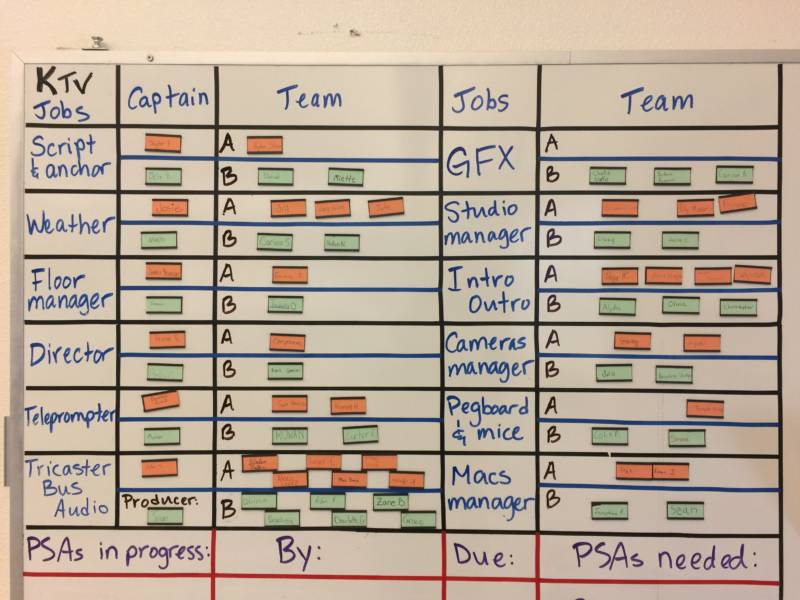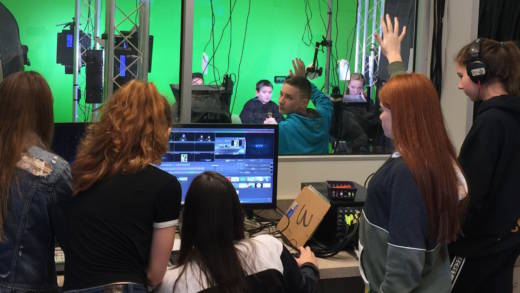When Jordan enters her Broadcast Media class at Kenilworth Junior High school, she doesn’t wait for directions from her teacher. She checks the job board, grabs a laptop and heads to her table to confer with her partner, Kyle. They are anchoring today’s news show, so they will spend the first part of class writing their script. They pull up the class website and navigate to a spreadsheet of announcements submitted by school staff members. They work together on a shared Google doc (also from the website) and coordinate with the weather and sports teams so they can incorporate their reports into their script.
In addition to Jordan and Kyle, there are 31 more seventh and eighth grade students in the class, all assigned jobs in the production of KTV, their school’s daily news broadcast.
- Studio Managers: set up lights, cameras and teleprompters at the start of class
- Script/Anchors: write script and anchor news show
- Weather: research and write weather forecast and make graphics; deliver report on air
- Sports: research and write sports report and make graphics; deliver report on air
- Graphics: make graphics for each news item
- On This Day…Team: research, write, film and edit movies to highlight events in history
- Film Crew: research, storyboard, film and edit movies (PSAs, school events, etc.)
- Floor Manager: collect, deliver, and confirm that graphics and videos are loaded on the tricaster prior to filming
- Producer: organize teams to prep for filming; supervise directors
- Audio Tech: set up, check and monitor audio for anchors
- Bus Tech: switch cameras during filming
- Tricaster Tech: manage videos, graphics, audio and recording during filming
- Directors: direct anchors during filming
- Teleprompter Tech: set up and pace teleprompters during filming
- Equipment Managers: confirm all equipment i
s shut down and stored after filming
 [/media-credit]
[/media-credit]From the time the first bell rings until the producer quiets the class for filming, the KTV room is abuzz with activity. Students move with authority around the room (and across campus), each responsible for elements of genuine broadcast media work. The stakes are high, as the scripts they write, the graphics they design or the movies they edit are not merely “turned in” to a teacher, but are published to a wide and meaningful audience. Our students know that the next day, during their morningclass, they will watch this episode of KTV, surrounded by their peers. That audience alone is significant enough to motivate 12 and 13-year-olds to do the best work they can. But the audience for our students’ work extends well beyond the walls of our classroom — parents and community members also stay up-to-date on school news by accessing KTV from the front page of the school website.
Far more meaningful than grades, the daily publication of the KTV students’ efforts provides a steady stream of feedback, affirmation and ownership, while also strengthening their ability to work in a self-directed environment. The work they do on any given day in the KTV studio is informed by their previous work, as the class critiques the published episodes, discusses what worked and what didn’t, and moves on to the next episode with specific plans for improvement. In addition to building academic skills such as writing, proofreading, presenting and speaking, KTV students practice professional broadcast skills, such as media production and behind-the-scenes technology. And woven through all of their work are skills critical to our professional and personal lives: collaboration, communication, creativity, critical thinking, responsibility, flexibility, and the problem-solving prowess that comes from working under pressure to produce a daily news show in a room full of people and unreliable technology.
In the final half hour of class, Jordan and Kyle wear the official KTV News Team shirts, sit at the anchor desk in the studio, and run through their lines while the teleprompter team paces the script. The producer rounds up the tech team and directors, and checks in with the floor manager to make sure the tricaster and bus tech have coordinated the show’s chronology. She quiets the room for filming and the show is now in the hands of the tech team, anchors and directors. When the show is over, the class applauds and then starts putting away the equipment, while the tech team uploads the show to YouTube and Twitter. Another episode is in the can; just another day in the studio for these kids.
